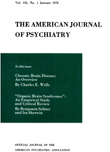ORGANIC COGNATES OF ACUTE PSYCHIATRIC ILLNESS
Abstract
One hundred selected (one of every 20) admissions to an acute psychiatric hospital were evaluated by means of independent psychiatric and neurologic, EEG and psychological examinations. Final diagnoses were established by means of longitudinal studies. It was determined that: 1) 60 percent of patients had no demonstrable organic brain disorder; 2) 20 percent had chronic brain disorders; 3) ten percent had acute brain disorders, mostly associated with alcoholism; 4) seven percent had functional mental illnesses in the presence of known central nervous system pathology and 5) three percent could not be classified as either with or without brain disorders.
Mental status examinations on admission which revealed no evidence of organic dysfunction were associated with final diagnoses of functional mental illness with rare exceptions. Admission mental status examinations showing defects of memory and typical changes in affect were significantly more often associated with definable brain damage. Impaired intellectual functioning and defects of judgment and states of confusion were encountered in both organic and functional disorders, especially in acute schizophrenics. EEG abnormalities were present in 60 percent of patients with organic brain disorders. Normal EEGs in this group (40 percent) were associated with acute and chronic brain syndromes associated with alcoholism and acute brain disorders related to amphetamine intoxication. Forty percent of patients without known organic diagnoses also displayed EEG abnormalities. Psychological test findings agreed with the final diagnosis in two-thirds of cases, with a similar rate of agreement for organic and nonorganic disorders. Disagreement of psychological test results with the final diagnosis was prone to occur in acutely disturbed schizophrenics and alcoholics.
These findings can provide some guidelines for clinical practice in similar settings. An admission mental status examination which reveals no typical indications of organic brain disorder is usually associated with a final diagnosis of "functional mental illness." A mental status examination, when done at the time of admission and which shows characteristic indications of organic impairment, is also predictive of a nonorganic final diagnosis if associated with a normal EEG, a negative psychological test result and a clinical history negative for alcoholism or other addiction. An admission mental status examination with organic findings in the absence of these conditions is generally associated with a final diagnosis of organic brain disorder.
Access content
To read the fulltext, please use one of the options below to sign in or purchase access.- Personal login
- Institutional Login
- Sign in via OpenAthens
- Register for access
-
Please login/register if you wish to pair your device and check access availability.
Not a subscriber?
PsychiatryOnline subscription options offer access to the DSM-5 library, books, journals, CME, and patient resources. This all-in-one virtual library provides psychiatrists and mental health professionals with key resources for diagnosis, treatment, research, and professional development.
Need more help? PsychiatryOnline Customer Service may be reached by emailing [email protected] or by calling 800-368-5777 (in the U.S.) or 703-907-7322 (outside the U.S.).



